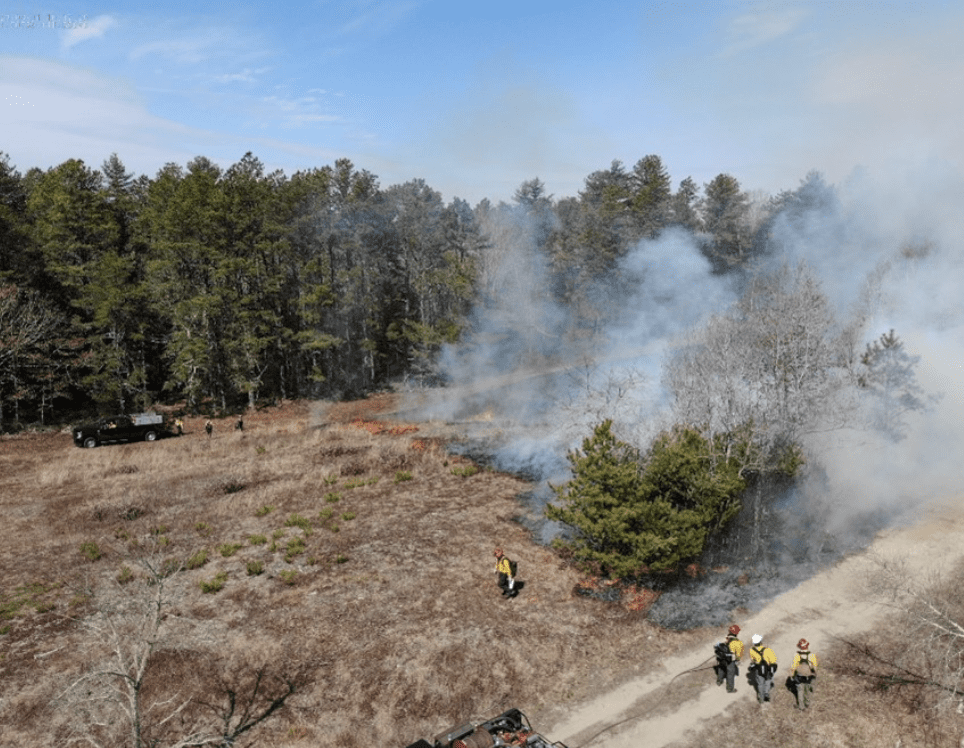Search Posts
Recent Posts
- Vinny Paz to be inducted TODAY into the International Boxing Hall of Fame – CES Boxing June 7, 2025
- In the News… quick recap of the week’s news (6.7.25) June 7, 2025
- Burn with Kearns: Strong without the spend: How scraps became strength tools – Kevin Kearns June 7, 2025
- Rhode Island Weather for June 7, 2025 – Jack Donnelly June 7, 2025
- How to advocate for threatened properties: The Heritage Alliance of Pawtucket June 7, 2025
Categories
Subscribe!
Thanks for subscribing! Please check your email for further instructions.

Defense against extreme fires, Rhode Island to do prescribed burn in Arcadia Management Area
Photo: DEM’s Forest Fire Program conducting a successful prescribed fire at Pratt Farm last spring. Credit: Jason Caswell, DEM Office of Emergency Response.
The Department of Environmental Management (DEM) has announced that depending on weather and wind conditions, DEM’s Forest Fire Program plans on conducting a low-severity prescribed burn at Pratt Farm in the Arcadia Management Area, located on the Exeter-Richmond line, on Thursday, March 14. There is no need for residents to contact emergency services if they see fire at Pratt Farm or smell the smoke emanating from it. DEM advises the public not to approach the area to avoid distracting the fire crews and unnecessarily occupying emergency personnel.
Last month, DEM announced plans to resume low-severity prescribed burns on state lands on Prudence Island and in Exeter, West Greenwich, Coventry, Richmond, and South Kingstown ahead of the spring prescribed fire season. Prescribed, or planned, burning is a versatile tool that natural resources managers use to maintain habitat diversity and to protect communities from extreme fires by reducing hazardous natural fuels.
DEM advises the public through press releases, timely social media posts, and distributing flyers to abutting landowners and neighbors after identifying a “burn window” in which to conduct a prescribed fire operation. A burn window refers to when the environmental variables such as fuel moisture and weather conditions are balanced so that the fire will accomplish its goals, which include reducing fuels (i.e., combustible materials on forest floors and in grasslands), modifying wildlife habitat, and restoring ecological function while remaining under control.
One of the biggest factors in determining a burn window is forecasting the weather. Whereas a 10-day forecast is accurate about only half the time, a five-day forecast can accurately predict the weather around 90% of the time, according to the National Oceanic and Atmospheric Administration. Wind is an equally critical factor. DEM’s “go/no-go” decision on which of the burns to conduct will likely come down to wind speed and direction, to allow for the optimal dispersal of smoke. DEM burn managers are targeting parcels at Pratt Farm in the Arcadia Management Area, Nicholas Farm Management Area in Coventry, Big River Management Area in West Greenwich, Prudence Island, Carolina Management Area in Richmond, and Great Swamp Management Area in South Kingstown.
“We will be working to build upon our successful prescribed fire projects from last spring, where we applied prescribed fire treatments to over 50 acres of fire adapted ecosystems on DEM managed lands,” said DEM Forest Fire Program Manager Pat MacMeekin. “It takes repeated implementation of prescribed fire treatments to fully restore fire adapted ecosystems. This will be the third consecutive year of good fire on the landscape, and we intend to build on the footprints from the last two years.
Although the goals of each prescribed fire project are unique to each individual property, the common goals are to reduce hazardous fuels, promote native plant species and wildlife habitat, and to train firefighters in wildfire response.” Rhode Island experienced a busy wildfire season in 2023, with DEM recording 78 wildfires encompassing 582 acres.
This total includes the Congdon Mill Fire in West Greenwich that covered nearly 196 acres and the worst-in-decades Queen’s River fire in Exeter that burnt 286 acres. These latter two fires happened back-to-back in April, with DEM leading the state’s response. Wildfires are expected to become more frequent in Southern New England due to climate change. DEM is responding by increasing the use of low-severity prescribed burns to reduce the build-up of combustible materials on forest floors and grasslands and by offering specialized wildfire training classes to build staff and volunteer capacity. By increasing its use of prescribed fire, Rhode Island is better aligning its land management policies and practices with neighboring states. Among other benefits, common ecological restoration goals with other states help to strengthen climate change resilience across southern New England.
Experts from DEM’s Forest Fire Program, a subsidiary of the Division of Agriculture and Forest Environment, will lead the prescribed burns. They will employ detailed operational and safety plans. Planning is critical for every burn. A prescribed burn plan developed by a qualified burn boss must be in place before a burn is conducted. Firebreaks and other site preparations are made. Fire behavior, fuels, and weather are monitored throughout the burn, and if the prescription parameters are exceeded, the fire is shut down. The burn is carried out by a skilled crew under the direction of a qualified burn boss. Abutting landowners are notified of fire dates, reasons, and expectations for the burn season. DEM burn managers have obtained the required local permits and an exemption from state air pollution control regulation
Managers also have communicated with the towns Fire Chiefs, Rhode Island Southern Firefighters League, US Fish and Wildlife Service, the DEM Division of Fish & Wildlife, and the DEM Office of Air Resources.
For more information on DEM programs and initiatives, visit www.dem.ri.gov. Follow DEM on Facebook, Twitter (@RhodeIslandDEM), or Instagram (@rhodeisland.dem) for timely updates.
___
